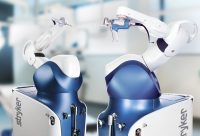
Mako robot-assisted total hip replacement
Modern hip replacement surgery was pioneered by Sir John Charnley in the UK in the early 1960s. The procedure and implant used were developed and refined over the next 30…

Modern hip replacement surgery was pioneered by Sir John Charnley in the UK in the early 1960s. The procedure and implant used were developed and refined over the next 30…

Total hip replacement surgery is one of the most successful, cost-effective and safest operations in the world today. However, despite its overall success rate, hip replacement surgery is a major…

With around 80,000 carried out each year, hip replacements are one of the most common elective surgical procedures in Britain. We speak to 41-year-old Rhys Gwilliam who managed 16 years…
Years of experience has given us insight into the questions you may have regarding hips and surgery.
We hope you find answers here but if you cannot find the answer to your question please call us on 01761 422 263 and we’ll endeavour to provide the best answer.
Hip pain is usually experienced in the groin, over the outer aspect of the hip or in the buttock region but can extend down the front of the thigh to the knee. It is rare for pain arising from the hip to be felt below the knee.
However, not all pain felt in the hip region is in fact from the hip. So-called referred pain, arising from the lower spine, can be experienced in the hip.
In addition to pain patients can report mechanical-type symptoms from the hip such as a catching/stabbing sensation or the feeling that the hip wants to give way.
Certain activities such as crossing the legs, deep bending (hip flexion) or getting in and out of a car, walking upstairs or up an incline or stumbling/jarring the hip can exacerbate hip symptoms.
It is unusual for surgery to be the ‘only option’. Patients are most concerned about pain particularly if it is constant present at night as well as during the day. Often hip pain can be improved with simple painkillers such as paracetamol or ‘over the counter’ anti-inflammatory medication such as ibuprofen.
Stronger prescription-only anti-inflammatory medication such as naproxen or diclofenac often works even when ibuprofen does not. The beneficial effects may take a week or two of taking the medication. Some patients report a positive response to homeopathic remedies such as glucosamine or chondroitin sulphate.
Many musculo-skeletal symptoms can be improved or relieved by working with a specialist physiotherapist. A course of therapy allows the physiotherapist to assess the effects of any therapy and work with the patient to resolve the problem.
Despite painkillers, anti-inflammatory medication and physiotherapy some patients’ symptoms persist. It is only at this stage when surgical options are discussed.
This depends on the problem that the patient has, their overall medical situation and the precise diagnosis that is reached. The role of the surgeon is to explain clearly to the patient what is the expected outcome in their specific condition.
Modern hip replacement surgery has developed in a progressive fashion since the early 1960’s. During the first three decades (1960’s, 1970’s and 1980’s) durable fixation of implants to the bone of the pelvis and femur was achieved. This can be either ‘uncemented’ or ‘cemented’. Both fixation types now have excellent long-term results.
The original bearing surface (i.e. the bits that rubs together in the joint) was a metal ball on a plastic cup. Since the late 1990’s the wear properties of the plastic have been significantly improved by a change in manufacturing processes creating highly cross-linked polyethylene. This has reduced the number of patients requiring revision or ‘re-do’ surgery.
The two most common bearings at the present time are metal-on-plastic and ceramic-on-plastic. Whilst the amount of wear at the bearing can be reduced by using a ceramic-on-ceramic bearing this has been associated with ‘squeaking’ on certain movements and, very rarely, ceramic fracture. It is for these two reasons that the use of a ceramic-on-ceramic bearing has become less popular over the past few years although it remains an option in the younger and more active population.
It had been hoped that the negative issues of squeaking and fracture in ceramic bearings but the positive effect of low wear at the bearing might be achieved by using a metal-on-metal bearing. Whilst this is still a viable option in the younger, active male patient by using a hip resurfacing implants due to the concern of metallosis (i.e. an adverse reaction to metal debris) metal-on-metal total hip replacements have now been withdrawn from the market. Any patient with a metal-on-metal hip replacement should be part of a follow up programme, usually at the hospital where the original operation took place.
To comply with referral guidelines all NHS funded patients will need to be referred from their own doctor to the musculo-skeletal service. This is usually locally although with ‘Choose and Book’ patients can opt to be seen away from the local area. In patients presenting with hip-related symptoms after the GP referral is made the majority of patients are assessed by an Interface Service (either a GP with an interest in musculo-skeletal medicine or by a physiotherapist).
Treatment may be offered before onward referral to a specialist Orthopaedic Surgeon be considered. This process can take several months.
Patients do have the option to consider a consultation directly with an Orthopaedic Surgeon on a private patient basis and although most patients are referred for this either by their GP or physiotherapist this is not a requirement and patients can arrange an outpatient consultation by contacting the private secretary of the Orthopaedic Surgeon. Any subsequent investigation or treatment can be either private or NHS depending on the patient’s choice. If the patient wishes to continue as an NHS funded patient then the Orthopaedic Surgeon will ask that the GP re-refer the patient via the NHS pathway.
The most common day to be discharged in the third post-operative day i.e. if your operation is on a Monday then you will most likely leave hospital on the Thursday. However, many patients are safe for discharge on the second post-operative day.
If you live alone it is quite feasible to be discharged home but you may wish to consider have a friend or family member come and stay with you for a week or so. Alternatively, you may wish to spend a period of time with a member of family or consider a week or two at a convalescent home. All these options can be discussed with Mr Burwell or with the team at the Pre-Admission Clinic.
Most patients do not return to driving until 6 weeks after surgery. If you have had a left hip replacement and have an automatic car you may consider returning to driving at 4 weeks after surgery. The Royal College of Surgeons have given advice on this issue – insert link here (Google ‘when can I drive after a hip replacement)
Matthew is one of only a few orthopaedic surgeons in the UK specialising exclusively in treating hip conditions. Replacements are a large part of his practice. Many patients are referred to him from other orthopaedic specialists.
Matthew Burwell
Consultant Orthopaedic Surgeon
Dave Hepburn
Specialist Senior Physiotherapist
Dr Graham Robinson
Consultant Radiologist
Hannah Nestor
Specialist Theatre Nurse
Laura Davies
Medical Secretary
